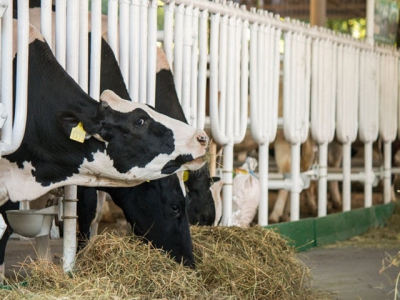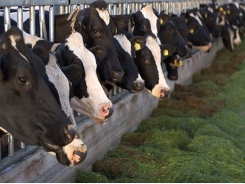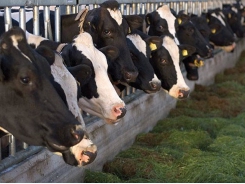Supplemental sodium acetate may boost milk fat

Adding sodium acetate, but not calcium butyrate, to the diets of dairy cows may improve milk fat yield and concentration, say researchers.
An international team of researchers from the Institute of Agricultural Research (INIA) in Chile and Pennsylvania State University in the US explored the use of sodium acetate and calcium butyrate as additives in dairy cow diets
The researchers found that adding sodium acetate to the control diet boosted dry matter intake by 2.7kg, increased milk fat yield by 90g per day and milk fat concentration by 0.2 percentage units compared to the control. However, the supplement was not linked to increased milk yield.
However, adding calcium butyrate to the feeds lowered dry matter intake, milk yield and milk fat yield, when compared to results from the control diet, the researchers said. Calcium butyrate use also had no effect on the concentration of milk fatty acids but adding sodium acetate increased the concentration and yield of 16 mixed source fatty acids (FA) and myristic acid.
“Milk fat yield and concentration can be increased by dietary supplementation of sodium acetate, and not calcium butyrate at the level investigated,” they said. “Increased milk fat synthesis observed during acetate feeding may be due to either a greater substrate supply allowing greater synthesis of de novo and mixed FA, modification of metabolism by acetate, or a combination of these.”
Why add sodium acetate or calcium butyrate to dairy diets?
The dairy industry watches the production of milk fat because it has a high market value, the researchers said. However, milk fat also is the most variable component in milk and it is the element most sensitive to the nutritional makeup of the diet.
Strategies to improve milk fat synthesis are of “special interest” to dairy industry members, they said.
Fatty acids (FA) in milk stem either from “de novo synthesis,” from absorption of plasma FA from the diet or, in the case of preformed FA, from “endogenous reserves”, they said. Acetate is the major substrate for de novo FA synthesis and is the primary volatile FA (VFA) generated in the rumen providing about 45% of the energy from VFA metabolism.
“Acetate is fundamental for meeting energy requirements and for milk fat synthesis in the dairy cow,” the researchers said. However, studies done previously looking at the role of acetate in milk fat synthesis were primarily done more than 30 years ago using non-modern diets and low-producing cows, they added.
“We recently reported that ruminal infusion of acetate neutralized to pH 6 increases milk fat yield (Urrutia and Harvatine, 2017a,b),” they said. “Acetate infusion also increased plasma BHB linearly at a rate of 5% per mole of acetate, possibly through conversion of acetate to butyrate in the rumen and rumen wall, and subsequent conversion to BHB.”
It remains unclear if all the increase in milk fat synthesis stemmed from acetate infusions or if the elevated plasma BHB also contributed, they said. A meta-analysis of past research found greater milk fat response linked to the infusion of butyrate than from acetate use.
“These data support a role for butyrate in stimulation of milk fat synthesis, but also provide a mechanism for increased milk fat synthesis observed during rumen infusion of acetate,” they said.
Feeding trial details
In the feeding trial, 12 dairy cows were given one of three diets for a 14-day period before being rotated to another of the trial diets, the researchers said. Each period included a 7-day “washout” and 7-days on the test diet.
The diets used included a basal diet with 3.2% NaHCO3 (sodium bicarbonate), the basal diet supplemented with 2.9% sodium acetate (NaAc), or the basal diet with 2.5% calcium butyrate (CaBu) as a percentage of dry matter, they said. The additives were mixed into the basal TRM for feeding.
All ingredients were sampled and checked for crude protein (CP), neutral detergent fiber (NDF) and acid detergent fiber (ADF), they said. Milk samples were collected the day prior to starting the test diet and on days 3, 6 and 7 of the trial periods and analyzed for milk fat and protein, milk fatty acid profile.
Blood samples were gathered twice on the final day of each feeding period, they said. Plasma samples were analyzed for glucose, non-esterified fatty acids, beta-hydroxybutyrate (BHB) and blood urea nitrogen (BUN).
Results
Overall, an interaction was found for dry matter intake (DMI) and the use of the NaAc supplement, the researcher said. The supplement increased intake by 2.5kg a day, while the CaBu additive lowered intake by 2.6kg a day compared to the control.
“Our data demonstrate that milk fat yield and concentration can be increased by feeding sodium acetate at 2.9% of diet dry matter, but not by feeding calcium butyrate at an equivalent carbon mass,” they said.
Adding NaAc to the diet was not found to alter milk yield, but adding CaBu lowered milk yield by more than 4% compared to control, they said.
“Milk fat yield was increased 90 g/d by NaAc and decreased 60 g/d by CaBu compared with control,” they said. “A treatment by time interaction was observed for milk fat concentration as NaAc increased milk fat concentration on d 3 and 7 compared with control (0.20 and 0.34 percentage points, respectively).”
Milk protein amounts were similar for cows on the control or the NaAc-supplemented diets, the researchers said. However, the supplement did increase milk protein yield the longer it was in the diet up to day three of the feeding period.
Milk protein levels fell for cows receiving the CaBu additive compared to control and use of the additive also lowered yield by day, they said.
“De novo FA were increased 50 g/d by NaAc on d 3 compared with control,” they said. “Calcium butyrate decreased de novo FA by 12 g/d on d 7, compared with control.”
“Sodium acetate also increased mixed source FA by over 50 g/d during the entire treatment period (d 3 to 7), compared with control,” they added.
Cows receiving the NaAc diet saw an increase in de novo FA on day 3, in mixed source FA on days 3 and 7, and a fall in preformed FA on days 3 and 7, the researchers said. Cows on the CaBu diet had an increase in de novo FA on day 7, a decline in mixed source FA on day 3 and a bump in preformed FA on day 3.
“The CaBu increased concentration of milk trans-10 C18:1 on d 3 and 7 of treatment (treatment by time interaction) indicating a shift in rumen biohydrogenation toward alternate pathways that result in biohydrogenation-induced milk fat depression,” they added.
Adding CaBu to the diets lowered plasma NEFA and increased BUN, compared to control group cow responses, they said. Plasma BHB increased for cows on the CaBu diet.
Source: Journal of Dairy Science
Authors: N. Urrutia, R. Bomberger, C. Matamoros, K. Harvatine
Related news
Tools

Phối trộn thức ăn chăn nuôi

Pha dung dịch thủy canh

Định mức cho tôm ăn

Phối trộn phân bón NPK

Xác định tỷ lệ tôm sống

Chuyển đổi đơn vị phân bón

Xác định công suất sục khí

Chuyển đổi đơn vị tôm

Tính diện tích nhà kính

Tính thể tích ao




 Seaweed slashes methane production in first live study…
Seaweed slashes methane production in first live study…  Traceability, data offers key to reducing deforestation risk…
Traceability, data offers key to reducing deforestation risk…